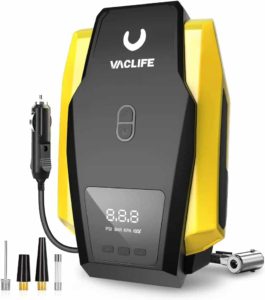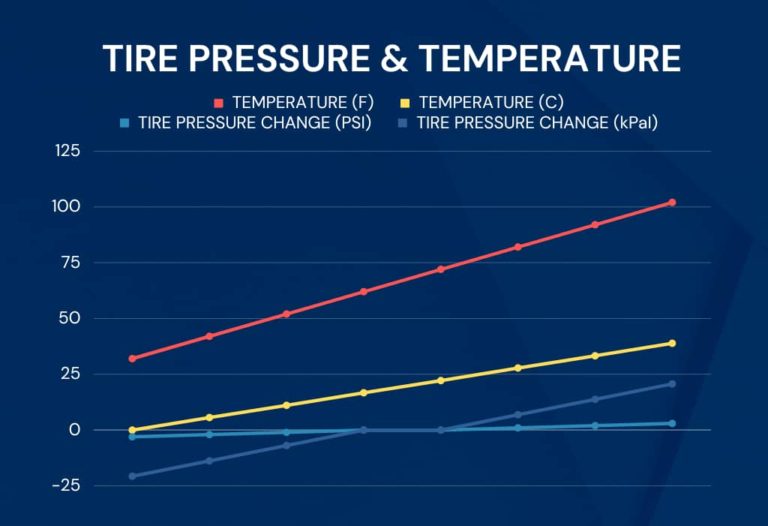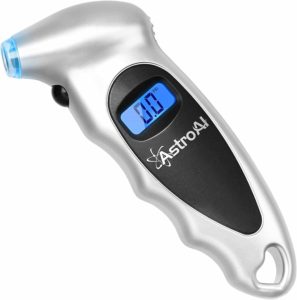The Kia K5 doesn’t have a button to reset the tire pressure. Don’t worry! Just follow this article and you’ll be able to turn off your tire pressure warning light without any issues.
What is the TPMS in a Kia K5?
The tire pressure monitoring system (TPMS) in the Kia K5 is a safety feature designed to alert the driver when tire pressure levels deviate from the optimal range. The system continually monitors the pressure in all four tires. If it detects a significant drop in pressure in any tire, an alert symbol appears on your vehicle’s dashboard. (Yellow exclamation point) This warning light enables you to take immediate action, ensuring a safer driving experience and optimal vehicle performance. To check your current tire pressure: Press the mode button on the steering wheel. Select “information mode” from the LCD display modes. The Kia K5 tire pressures are supposed to be 35 Psi in the front and rear tires.
2023 Kia K5 Tire Pressures
Tire Size | FRONT PSI | REAR PSI |
205/65R16 | 35 | 35 |
235/45R18 | 35 | 35 |
245/40R19 | 35 | 35 |
SPARE TIRE | 60 | 60 |
Kia K5 Tire Pressure Light Reset Procedure
The Kia K5 does not have a tire pressure reset button.
When the tire pressure light on the dashboard lights up, pull over and check your tire pressure right away.
Determine which tire is causing the tire pressure light to turn on and adjust the tire pressure accordingly.
Fill your tire to the exact recommended pressures. I cannot emphasize this enough, accuracy is key. 35 Psi.
Drive your Kia K5. Drive for a few minutes at speeds over 20 Mph.
If the light doesn’t go off right away, re-check your tire pressure to make sure they are all at the exact pressure you set them to. If they are down in pressure, you probably have some sort of tire leak.
If the pressures are at the exact pressure you set them to and the tire light still won’t go off, over fill your tires.
We recommend filling your problem tire with 45 Psi or about 10 Psi over the recommended pressure. With the tire overfilled, drive the car again for 10 or 15 minutes. This will turn off the tire light.
Now that the tire light is off, readjust the pressure back to 35 Psi.
How Does the Kia K5 TPMS Work?
Tire Pressure Sensors: Each of the four tires on your Kia K5 has a sensor embedded within it. This sensor is responsible for continuously monitoring the air pressure within the tire. It measures the current tire pressure in pounds per square inch (PSI) and sends this information wirelessly to the car’s control module.
Control Module: The control module, also known as the TPMS ECU (Electronic Control Unit), receives the wireless signals from each tire’s pressure sensor. It processes this information to determine whether the pressure in any of the tires is outside the preset safe range. This range is set by Kia to ensure optimal tire performance and safety.
Comparing Pressure Levels: The control module compares the tire pressure levels reported by the sensors against the preset safe range. If the tire pressure in any of the tires falls below (or exceeds) this range, it triggers an alert to the driver. For example, the range uses 10 or 15% as its threshold. So, 15% of 35 Psi is 5.25 Psi. This means when the tires are at 30 Psi (35 – 5), the Kia K5 will activate the warning light on your LCD.
Warning Light: Once an alert is triggered, the TPMS warning light (which looks like an exclamation point) illuminates on the vehicle’s dashboard. This is the visual cue to you that something is wrong with the tire pressure.
Driver’s Response: When the TPMS warning light comes on, it indicates that you need to check your tire pressure and inflate or deflate your tires as needed. You should use an accurate tire pressure gauge to confirm the pressure in each tire and adjust it to the recommended PSI, 35.
Resetting the TPMS: After adjusting the tire pressure, you may need to reset the TPMS. Follow the steps above.
Continual Monitoring: The TPMS continues to monitor tire pressure while the vehicle is on. If the tire pressure changes significantly while driving, the system will alert the driver again.
Kia TPMS Malfunction Indicator
The Kia K5 also has a different warning light to alert you when something is wrong with the tire pressure monitoring system (TPMS). This warning light displays a yellow exclamation point, identical to the tire warning light. If there is a problem with the TPMS, the light will flash for approximately one minute before staying on. This sequence will occur every time you start your car until the issue is resolved. So, when your tire light is flashing or blinking, the system will not be able to detect low tire pressure. In conclusion, a blinking tire pressure light usually means there is a malfunction within the TPMS itself, rather than an air pressure issue. This is usually due to a defective pressure sensor in one of your tires (a dead battery). To determine which sensor is faulty, use a TPMS diagnostic tool.
What are Common Causes for the Tire Light to Turn On?
Seasonal temperature changes: A drop in ambient temperature can cause tire pressure to decrease, triggering the warning light.
Tire puncture or leak: A sharp object or road debris like a nail or screw may puncture a tire, causing air loss which will of course activate the warning light.
Faulty tire pressure sensor: Damaged or malfunctioning sensors may provide inaccurate readings, resulting in a false alert. The only way to determine which sensor is faulty is to scan each sensor with a TPMS diagnostic tool.
Valve stem issues: A damaged or leaking valve stem can lead to gradual pressure loss and eventual activation of the tire pressure light. They make kits to replace the rubber gasket that usually goes bad.
Tire damage: Impact from potholes or hitting a curb can cause structural damage like tire bubbles, leading to pressure loss.
Sensor battery life: TPMS sensors are battery-powered, and over time, batteries die. (they usually last anywhere from 5-10 years) This will cause the tire pressure light to turn on. Again, you must use a diagnostic tool to determine which sensor is dead or dying.
Recent tire rotation or replacement: If the tires have been recently rotated or replaced, the TPMS may need recalibration to avoid false alerts. Sometimes the vehicle’s computer may think the front tires are in the rear and rear in the front after a rotation.
Wheel or rim issues: Damaged, corroded, or cracked wheels or rims can lead to air leaks and pressure loss. This is very common with low profile tires.
Altitude changes: Climbing or descending in elevation can affect tire pressure and trigger the TPMS warning. An additional 1.5 Psi per Km above sea level is required.
Natural pressure loss: Tires lose air pressure over time due to temperature changes and permeation. Tire dry-rot will happen to tires that sit.
Electrical problems or software issues within the car’s TPMS system. Occasionally the system may have a software update from Kia.
What Happens When Tires are Underinflated?
Underinflated tires can have several impacts on your Kia K5, including:
Decreased Fuel Efficiency: Underinflated tires will lower your gas mileage, as they create more rolling resistance, which means the engine has to work harder to keep the car moving.
Poor Handling: Underinflated tires may result in poor vehicle handling and unresponsive steering. This is because the tire doesn’t maintain its optimal shape and provides less traction, making it harder for the vehicle to grip the road, especially in wet conditions.
Increased Tire Tread Wear: Underinflated tires tend to wear out more quickly, especially along the edges. This can lead to premature tire replacement.
Overheating: Underinflated tires are more prone to overheating because they create more friction against the road. Overheating can lead to tire failure, including blowouts.
Longer Stopping Distances: Underinflated tires can increase stopping distances, reducing the effectiveness of your braking system and potentially increasing the risk of accidents.
Rougher Ride: Underinflated tires may lead to a less comfortable ride, as they absorb bumps and potholes less effectively than properly inflated tires.
What Happens When Tires are Overinflated?
Overinflated tires can also cause several problems for your Kia K5, including:
Reduced Traction: Overinflated tires have less contact with the road surface, reducing the amount of grip and making the car harder to handle, particularly in wet and icy conditions.
Increased Wear in the Center of the Tire: Overinflation causes the middle section of the tire to bulge, resulting in uneven and increased tread wear in this area. This can also lead to premature tire replacement.
Harsher Ride: Overinflated tires are less effective at absorbing road imperfections like bumps and potholes, also leading to a rougher, less comfortable ride.
Increased Risk of Tire Damage: Overinflated tires are more susceptible to damage from potholes, debris, and other road hazards. They’re also more likely to suffer from a blowout due to the increased internal pressure.
Longer Braking Distance: Overinflated tires can lead to longer stopping distances because of the reduced traction. This increases the risk of accidents.
Decreased Tire Life: Overinflation can reduce the overall lifespan of your tires, leading to more frequent replacements and higher maintenance costs.
How Does the Weather Affect Tire Pressure?
The weather can have a real impact on your tire pressure. When it’s cold outside, the air inside your tires contracts. This causes the pressure to decrease. This is why you might notice your tire pressure warning light comes on during a frosty winter morning. On the flip side, when it’s hot outside, the air inside your tires will expand. This causes the pressure to increase. This fluctuation in tire pressure is normal! A general rule to keep in mind is that for every 10-degree change in temperature, your tire pressure will drop by around 1 Psi.
How to Check Your Tire Pressure
Get a high-quality tire gauge.
Make sure to check the tire pressure when the tires are cold. “Cold” means your vehicle has been idle for at least three hours or driven less than 1 mile in the past 3 hours.
Take off the valve cap from the tire valve stem.
Push the tire gauge firmly onto the valve to measure the pressure.
Compare the pressure reading with the recommended pressure on the tire information label. 35 Psi.
If the pressure is lower than 35 Psi, add air.
If the pressure is too high, let out some air by pressing the metal stem in the center of the tire valve. You can use any object like a screwdriver to do this. Be gentle.
Recheck the tire pressure with the gauge.
Don’t forget to put the valve caps back on to prevent leaks and keep dirt and moisture out.
When Should You Adjust your Tire Pressure?
The optimal time to adjust your Kia K5’s tire pressure is in the morning or when your vehicle has been parked for a few hours. This is because your tires should be cold when you’re checking and adjusting the pressure. When you drive, the tires heat up, which can cause the air inside to expand and give a higher pressure reading. Do not adjust your tire pressure when your tires are hot, it will not be accurate and can lead to more issues! To get the most accurate tire pressure measurement, make sure your car has been parked for a few hours.
Conclusion
Maintaining proper tire pressure in your Kia K5 is essential for ensuring optimal vehicle performance, fuel efficiency, and safety. It’s crucial to regularly monitor your tire pressure, especially during seasonal changes or after any significant shift in temperature. While the TPMS provides helpful alerts, it’s not a substitute for manual checks and tire maintenance. Remember, the TPMS alerts you when tire pressure is already too low or too high, so regular checks can help you stay ahead of any issues. Lastly, whether you’re dealing with underinflation or overinflation, it’s always important to adjust your tire pressure back to the recommended 35 PSI for the best driving experience. Drive safe and keep those tires in check! Everything in this article is applicable to all Kia K5 models and trims. Including, K5 GT-line FWD, GT-line AWD, EX, and GT.





